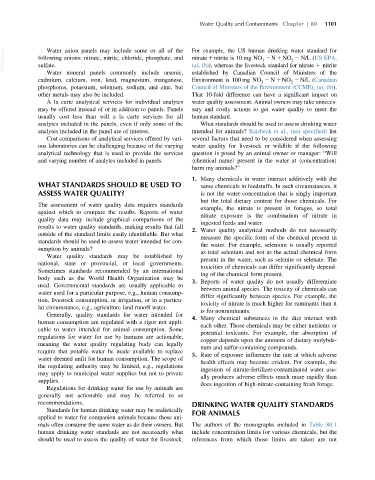Page 1169 - Veterinary Toxicology, Basic and Clinical Principles, 3rd Edition
P. 1169
Water Quality and Contaminants Chapter | 80 1101
VetBooks.ir following anions: nitrate, nitrite, chloride, phosphate, and For example, the US human drinking water standard for
Water anion panels may include some or all of the
2
2
nitrate 1 nitrite is 10 mg NO 2N 1 NO 2 N/L (US EPA,
2
3
sulfate.
(a), (b)), whereas the livestock standard for nitrate 1 nitrite
Water mineral panels commonly include arsenic, established by Canadian Council of Ministers of the
2 2
cadmium, calcium, iron, lead, magnesium, manganese, Environment is 100 mg NO 2 N 1 NO 2 N/L (Canadian
3 2
phosphorus, potassium, selenium, sodium, and zinc, but Council of Ministers of the Environment (CCME), (a), (b)).
other metals may also be included. That 10-fold difference can have a significant impact on
`
A la carte analytical services for individual analytes water quality assessment. Animal owners may take unneces-
may be offered instead of or in addition to panels. Panels sary and costly actions to get water quality to meet the
usually cost less than will a la carte services for all human standard.
analytes included in the panels, even if only some of the What standards should be used to assess drinking water
analytes included in the panel are of interest. intended for animals? Raisbeck et al., (not specified) list
Cost comparisons of analytical services offered by vari- several factors that need to be considered when assessing
ous laboratories can be challenging because of the varying water quality for livestock or wildlife if the following
analytical technology that is used to provide the services question is posed by an animal owner or manager: “Will
and varying number of analytes included in panels. hchemical namei present in the water at hconcentrationi
harm my animals?”
1. Many chemicals in water interact additively with the
WHAT STANDARDS SHOULD BE USED TO same chemicals in feedstuffs. In such circumstances, it
ASSESS WATER QUALITY? is not the water concentration that is singly important
but the total dietary content for those chemicals. For
The assessment of water quality data requires standards
example, the nitrate is present in forages, so total
against which to compare the results. Reports of water
nitrate exposure is the combination of nitrate in
quality data may include graphical comparisons of the
ingested feeds and water.
results to water quality standards, making results that fall
2. Water quality analytical methods do not necessarily
outside of the standard limits easily identifiable. But what
measure the specific form of the chemical present in
standards should be used to assess water intended for con-
the water. For example, selenium is usually reported
sumption by animals?
as total selenium and not as the actual chemical form
Water quality standards may be established by
present in the water, such as selenite or selenate. The
national, state or provincial, or local governments.
toxicities of chemicals can differ significantly depend-
Sometimes standards recommended by an international
ing of the chemical form present.
body such as the World Health Organization may be
3. Reports of water quality do not usually differentiate
used. Governmental standards are usually applicable to
between animal species. The toxicity of chemicals can
water used for a particular purpose, e.g., human consump-
differ significantly between species. For example, the
tion, livestock consumption, or irrigation, or in a particu-
toxicity of nitrate is much higher for ruminants than it
lar circumstance, e.g., agriculture land runoff water.
is for nonruminants.
Generally, quality standards for water intended for
4. Many chemical substances in the diet interact with
human consumption are regulated with a rigor not appli-
each other. Those chemicals may be either nutrients or
cable to water intended for animal consumption. Some
potential toxicants. For example, the absorption of
regulations for water for use by humans are actionable,
copper depends upon the amounts of dietary molybde-
meaning the water quality regulating body can legally
num and sulfur-containing compounds.
require that potable water be made available to replace
5. Rate of exposure influences the rate at which adverse
water deemed unfit for human consumption. The scope of
health effects may become evident. For example, the
the regulating authority may be limited, e.g., regulations
ingestion of nitrate-fertilizer-contaminated water usu-
may apply to municipal water supplies but not to private
ally produces adverse effects much more rapidly than
supplies.
does ingestion of high-nitrate-containing fresh forage.
Regulations for drinking water for use by animals are
generally not actionable and may be referred to as
recommendations. DRINKING WATER QUALITY STANDARDS
Standards for human drinking water may be realistically FOR ANIMALS
applied to water for companion animals because those ani-
mals often consume the same water as do their owners. But The authors of the monographs included in Table 80.1
human drinking water standards are not necessarily what include concentration limits for various chemicals, but the
should be used to assess the quality of water for livestock. references from which those limits are taken are not

